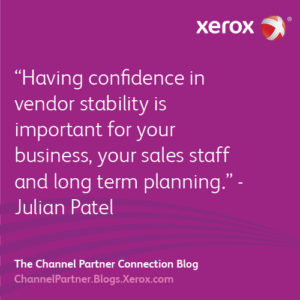
Other times there’ll be a whole paradigm shift (perhaps caused by disruptive new technology) that requires us to reassess our business model so we can take advantage of it.
I’m a firm believer in the motto ‘with change comes opportunity’ – but what does that mean here?
How is the print supplies market changing today?
There are several forces are at play today:
- The worldwide enterprise print market is expected to decline by 2% in 2016 (Source: Gartner)
- Global demand for toner cartridges is increasing and is expected to achieve an annual compound growth rate of over 9% by 2019 (Source: Technavio)
- Some vendors are divesting and there’s evidence of on-going market consolidation (Dell leaving EMEA printer hardware market, Lexmark acquisition by Apex and the HP company split)
How is customer behaviour changing?
In Carlo Longhi’s April blog – How to adapt your business model and thrive – he discussed how customer purchasing behaviour is changing and many SMBs now look to a single supplier to fulfil all their print needs. A very different model to the one we’re traditionally used to.
In addition:
- Many SMBs shop around for the best deal, but it’s often an unrewarding, tedious task
- There’s increased demand for colour printing
- The ‘green’ issues are still very important to SMBs
How to optimise change whilst minimising your business risk
1 – Recognise that print is a GROWING opportunity
With an increasing demand for toner cartridges, there’s profit to be made from supplies across your customers’ entire print fleet. This subject is discussed in my previous blog post: 5 Reasons Why There is Profit in Selling Supplies
2 – Tell your customers about the risks associated with cloned cartridges
Your customers care about the environment and about their budgets. Tell them how cloned cartridges are often manufactured to poor standards and sometimes end up in landfill sites – then, how you can offer a better alternative.
3 – Be sure to back the right horse
Choosing the right vendor at a time of market consolidation is important. Sustainability is key, as is a track record of growth.
I remember a conversation with the owner of a large partner who reiterated this sentiment: “I’m only interested in doing business with vendors who are going to be around in 10 years’ time.” Having confidence in vendor stability is important for your business, your sales staff and long term planning.
4 – Focus on your core competencies
Don’t be tempted to diversify. I am 100% confident there is enough opportunity, even in today’s changing market, to simply do what you do best – AND grow a successful business.
5 – Work with your chosen vendor
Make sure the vendors you work with are there to support your business success.
A vendor who continually looks for opportunities to help you grow (for example with high margins on Xerox supplies for non-Xerox printers), products that help you lock in customers through value added and differentiated services (such as Xerox Supplies Service and Lifetime Warranty) and supports you with special pricing deals for those important bids.
And what of the future?
I’m sure we will look back at this time as a pivotal moment for everyone associated with print. And I am convinced those that decide to grow and change with the evolutionary direction of the market will be the same businesses who are around in 10 years’ time – helping to shape the future of our industry.
Talk to your vendor, including Xerox, to see how you can profit from change. We at Xerox will only grow as you, our channel partners, grow; therefore, we must work together to make you as successful as possible.
Subscribe to the Channel Partner Connection and receive email updates when we publish a new article.



